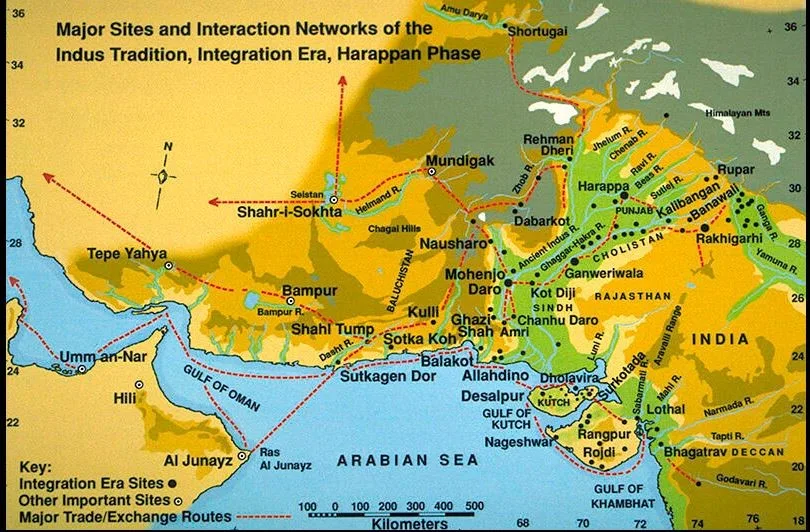Syllabus: GS1/ History and Culture
Context
- September 20, 2024 marks the centenary of the announcement of the discovery of the Indus Valley civilisation.
Harappan Civilization
- The Harappan civilization is believed to be one of the oldest world civilizations together with Egypt and Mesopotamia.
- It was developed along the river Indus and for that reason it is also known as the Indus Valley Civilization.
- The Harappan civilization is identified as a Bronze-age civilization because many objects have been found that are made up of copper based alloys.
- Daya Ram Sahni first excavated Harappa in 1921-22, and Rakhal Das Banerji in 1922 started excavating Mohenjo-daro.
Vast civilisation
- The Harappan civilisation can be divided into an;
- Early phase (3200 BCE to 2600 BCE),
- The mature period (2600 BCE to 1900 BCE), and
- The late phase (1900 BCE to 1500 BCE), when it decayed and collapsed.
- Today it spans 2,000 sites across 1.5 million sq. km in India, Pakistan, and Afghanistan.
- There are about 1,500 sites in northwestern India, including in Gujarat, Haryana, Jammu and Kashmir, Maharashtra, Rajasthan, and Uttar Pradesh.
- There are about 500 sites in Pakistan, and a few in Afghanistan.
- Mohenjo-daro, Harappa, Ganweriwala (all now in Pakistan), Rakhigarhi, and Dholavira (both in India) are the five biggest Harappan sites.
Significance of discovery
- Most historians were of the opinion that settled life in this part first occurred around the sixth century BCE, leaving a gap in South Asian history.
- The discovery of the Harappan civilisation filled the so-called gap.
- Also the discovery added one more ancient civilisation in Asia, besides the Egyptian and the Mesopotamian, and unravelled the Harappan civilisation’s maritime contacts with West Asia from 3000 BCE.
Major Features of Civilization
- Urban Planning: Their towns were well planned and they had brick houses which were situated along the roads.
- Every house was equipped with a staircase, a kitchen and several rooms.
- Their courtyards had wells, bathrooms and they had proper drainage systems.
- Ornaments: The Harappans wore ornaments made of gold, silver, ivory,shell, clay, semi-precious stones and others.
- Trade and Commerce: The civilization had extensive trade networks, reaching as far as Mesopotamia, Afghanistan, and the Arabian Peninsula.
- Religion and Iconography: Harappan artifacts depict various symbols and motifs believed to be related to religious beliefs.
- These include figures such as the “Priest King” and images of animals like bulls, suggesting possible reverence for certain animals.
- Craftsmanship and Artistry: The Harappans produced intricate pottery, including the famous red pottery with black painted motifs.
- They also created jewelry, sculptures, and seals made of steatite, terracotta, and other materials.
- Agriculture: They cultivated crops such as wheat, barley, peas, and cotton.
- Social Organization: The society was likely stratified, with evidence suggesting a hierarchical structure. This is indicated by variations in housing sizes and the presence of public buildings.
- Decline and Disappearance: The reasons for the decline of the Harappan Civilization are still debated among historians and archaeologists.
- Possible factors include ecological changes, such as shifts in river courses, as well as invasions and internal conflicts.
Major Harappan Sites
| Site | Present Day |
|---|---|
| Harappa | Punjab, Pakistan |
| Mohenjo-Daro | Sindh, Pakistan |
| Dholavira | Kutch district of Gujarat, |
| Kalibangan | Rajasthan |
| Lothal | Gujarat |
| Rakhigarhi | Haryana |
| Chanhudaro | Sindh, Pakistan |
| Ganweriwala | Punjab, Pakistan |
| Sutkagendor | Baluchistan Province, Pakistan |
| Alamgirpur | Uttar Pradesh |

Concluding remarks
- For the past 100 years, the Harappan civilisation has mesmerized and baffled town planners, epigraphists, metallurgists, astronomers, and others. Its enigmas have intrigued them.
- At the apogee of its prosperity, it was a “technological powerhouse” that excelled in town planning, harvesting water, building reservoirs, warehouses, underground sullage systems, massive fortification walls and building seafaring boats etc.
Source: TH
Previous article
News In Short-19-09-2024
Next article
Food Processing Sector in India